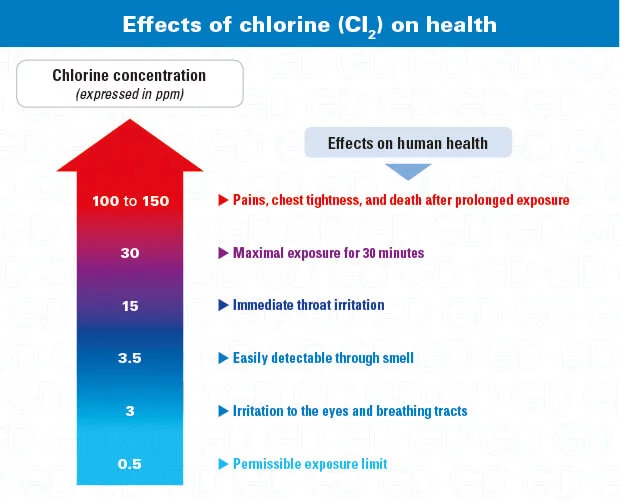Chlorine – Cl2
Chlorine – Cl2 – or Here chlorine – ( Cl2 ) you can find basic information about: properties, health effects, detection devices and systems ( chlorine gas detector ) and appropriate respiratory protective equipment (gas mask or B with gas filter powered air purifying respirator).
Chlorine properties (Cl2)
Historically known to have been used as a chemical weapon (mustard gas) during World War I chlorine ( Cl2 ) is widely used as a biocide (to destroy bacteria) during the water purification process due to its disinfectant properties. It is also used in other industries such as the chemical industry (herbicide and pesticide production), textile and paper industries (as a bleaching agent).
- CAS
- 7782-50-5
- TWA (8 hours)
- –
- STEL (15 minutes)
- 0,5 ppm
- LEL
- –
- IP
- 11.48 eV
- DENSITY/AIR
- 2,49
- FILTER/AIR
- B
Health effects of chlorine
Chlorine ( Cl2), especially sharp And stifling It is a yellow-green gas with an odor. This highly toxic gas (R23), irritating to skin (R38), eyes (R36) and respiratory system (R37). It is extremely harmful to human health and the environment, especially since it reacts with water. hydrochloric acid (HCl) or hypochlorous acid It can form (HOCl).
Chlorine gas detector
Even if chlorine is visible and smelly, it is only a chlorine gas detector can accurately measure concentrations of this highly toxic gas. Therefore, ppm or ppb to effectively monitor chlorine gas. Cl2 detection solution should be selected.
Chlorine calibration gas cylinders are available for calibration and gas testing of your fixed or portable gas detectors.
Chlorine respiratory protection (Cl2)
Since chlorine is very irritating to the eyes, use a chlorine respirator (usually full face mask) or for appropriate respiratory protection B with gas filter equipped with a much more comprehensive powered air purifying respirator It is recommended to use . If concentrations exceed 60 times the OEL, a self-contained breathing apparatus (SCBA) is required.



